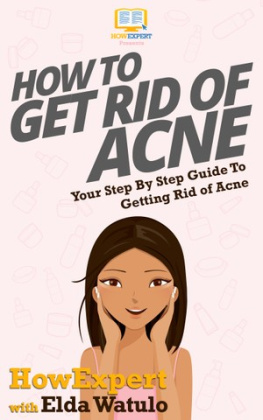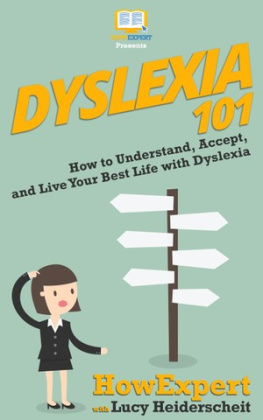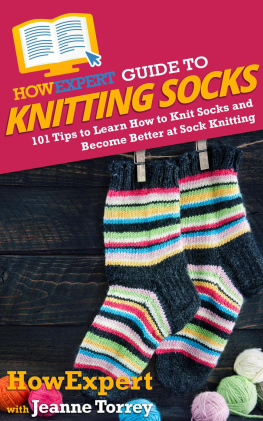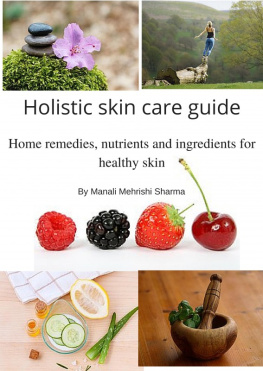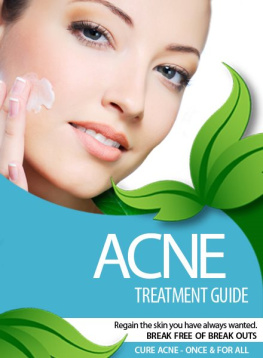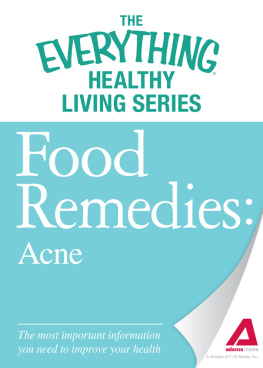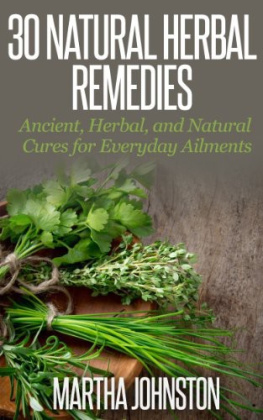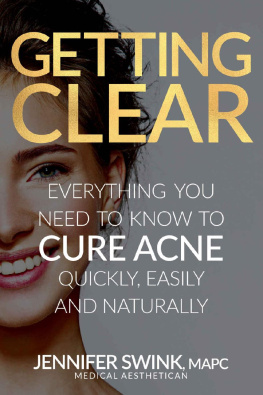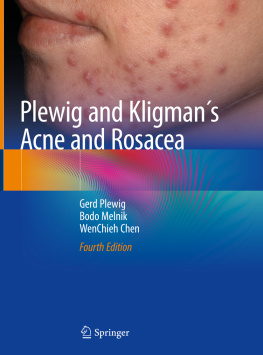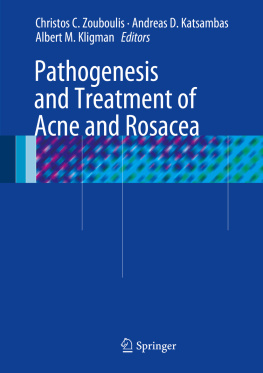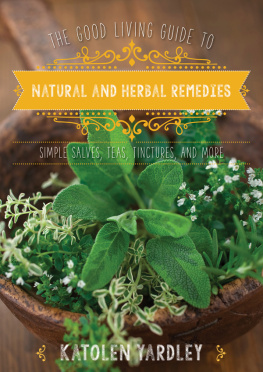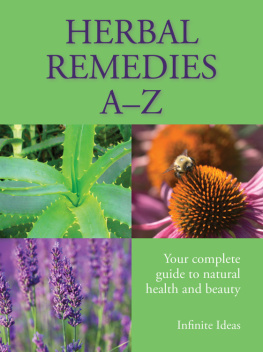HowExpert Presents
How To Get Rid Of Acne
Your Step By Step Guide To Getting Rid Of Acne
HowExpert with Elda Watulo
Copyright HowExpert
www.HowExpert.com
For more tips related to this topic, visit HowExpert.com/acne .
Recommended Resources
- HowExpert.com Quick How To Guides on All Topics from A to Z by Everyday Experts.
- HowExpert.com/free Free HowExpert Email Newsletter.
- HowExpert.com/books HowExpert Books
- HowExpert.com/courses HowExpert Courses
- HowExpert.com/clothing HowExpert Clothing
- HowExpert.com/membership HowExpert Membership Site
- HowExpert.com/affiliates HowExpert Affiliate Program
- HowExpert.com/writers Write About Your #1 Passion/Knowledge/Expertise & Become a HowExpert Author.
- HowExpert.com/resources Additional HowExpert Recommended Resources
- YouTube.com/HowExpert Subscribe to HowExpert YouTube.
- Instagram.com/HowExpert Follow HowExpert on Instagram.
- Facebook.com/HowExpert Follow HowExpert on Facebook.
COPYRIGHT, LEGAL NOTICE AND DISCLAIMER:
Copyright by HOWEXPERT (OWNED BY HOT METHODS). All Rights Reserved Worldwide. No part of this publication may be reproduced in any form or by any means, including scanning, photocopying, or otherwise without prior written permission of the copyright holder.
Disclaimer and Terms of Use: Please note that much of this publication is based on personal experience and anecdotal evidence. Although the author and publisher have made every reasonable attempt to achieve complete accuracy of the content in this Guide, they assume no responsibility for errors or omissions. Also, you should use this information as you see fit, and at your own risk. Your particular situation may not be exactly suited to the examples illustrated here; in fact, it's likely that they won't be the same, and you should adjust your use of the information and recommendations accordingly.
The author and publisher do not warrant the performance, effectiveness or applicability of any sites listed or linked to in this book. All links are for information purposes only and are not warranted for content, accuracy or any other implied or explicit purpose.
Any trademarks, service marks, product names or named features are assumed to be the property of their respective owners, and are used only for reference. There is no implied endorsement if we use one of these terms.
No part of this book may be reproduced, stored in a retrieval system, or transmitted by any other means: electronic, mechanical, photocopying, recording, or otherwise, without the prior written permission of the author.
Any violation by stealing this Book or downloading or sharing it illegally will be prosecuted by lawyers to the fullest extent. This publication is protected under the US Copyright Act of 1976 and all other applicable international, federal, state and local LAWS and all rights are reserved, including resale rights: you are not allowed to give or sell this Guide to anyone else.
This publication is designed to provide accurate and authoritative information with regard to the subject matter covered. It is sold with the understanding that the authors and publishers are not engaged in rendering legal, financial, or other professional advice. laws and practices often vary from state to state and if legal or other expert assistance is required, the services of a professional should be sought. the authors and publisher specifically disclaim any liability that is incurred from the use or application of the contents of this book.
COPYRIGHT BY HOWEXPERT (OWNED BY HOT METHODS)
ALL RIGHTS RESERVED WORLDWIDE.
Table of Contents
What is Acne?
Acne can be defined as a specific skin inflammation that is mainly brought about by the over-activity of oil glands at the base of hair follicles. Acne is a form of skin condition with surface pimples as well as deep lumps that forms on the face, chest, back, neck and shoulders. Acne condition occurs in young people quite often. It is extremely upsetting to many people, especially the models, to be disfigured by acne.
The male hormone, both in men and women, stimulates the oil glands around puberty and as a result of this, acne occurs. The oil is secreted through the skin openings by the oil glands which are located just beneath the skin. This oil normally plays a very important role of lubricating the skin. The cells which are located close to the openings of the oil glands, under certain circumstances, block the openings resulting in a buildup of oil underneath the skin. The skin bacteria will then feast on this buildup of oil, start multiplying and as a result lead to inflammation of the surrounding tissues. The inflammation will cause acne and the depth of the inflammation determines the type of acne. A pustule is caused by the inflammation right near the surface; a pimple (papule) is caused by a deeper inflammation while a much deeper inflammation causes a cyst. Whiteheads are brought about when oil breaks through the surface while blackheads are caused by oxidation of the oil.
Normally, acne attacks the skin areas that have the densest population of sebaceous follicles. Such skin areas include the face and the back, as well as the upper part of the chest. Although in severe cases it is inflammatory, acne can present itself in non-inflammatory forms. In as much as acne is more prevalent during adolescence, in some cases, it continues into adulthood. In most cases, acne starts at puberty and reduces as time goes. The time the acne will disappear completely in ones lifetime is normally hard to tell and some people can continue having it into their forties or even beyond.
Signs and Symptoms of Acne
The signs as well as symptoms of acne normally go beyond those of normal pimples. Typical acne is characterized by: blackheads, pustules, papules, nodules, and whiteheads as well as cysts.
Types of Acne
Basically, acne can be categorized as either inflamed or non-inflamed. The inflamed acne can be described by inflammation as well as redness. The victims of inflamed acne will have blackheads, papules, microcomedones, pustules, nodules as well as cysts. The symptoms and signs of this type of acne include swelling, redness, crusting, lesions, scrambling, oozing as well as irritation of the skin. The acuteness of inflamed acne differs and can be mild or extremely severe. The most serious form of inflamed acne is cystic acne. In most cases, the victims of the inflamed acne are exposed to the risk of skin damage as well as scarring.
The non-inflamed acne breakouts include milia, blackheads, as well as the microcomedones. Symptoms and signs of the non-inflamed acne include uneven skin texture and bumpiness on the skin surface. Although the non-inflamed acne is not visible, it makes the skin feel sandpapery or rough. If not well treated, the non-inflamed acne will develop into the inflamed acne.
Blackheads
Blackheads fall under the category of the non-inflammatory acne; they are normally referred to as open comedonal or grade I acne. As discussed earlier, blackheads come about as a result of dead skin cells clogging the pores, obstructing the usually drainage of sebum and thus making it accumulate underneath the epidermis; exposure of these accumulated sebum to air leads to its oxidation and hence blackheads are formed.
Whiteheads and milia
Whiteheads, also known as the comedonal acne, develop almost in the same way as blackheads. The difference between the two is that, with the whiteheads, the accumulation of the oil does not occur due to blockages but rather because of a closed or narrow pore. For the milia, sebum as well as bacteria is not involved in its formation.
Next page
